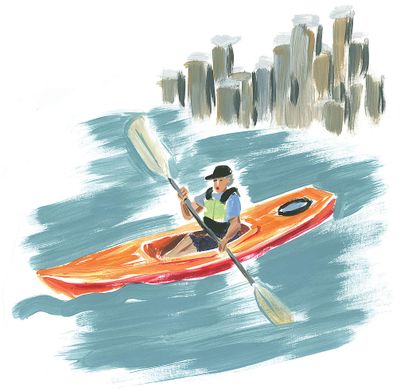S-R outdoor writing contest winner: The Vanishing Lake

The kayak slips through slate-gray water, so still this morning that the only movement comes from the pull of the paddle, the only sounds from an occasional bird trill or cricket chirp. I am at the western edge of a lake whose shape resembles a sea serpent on topographical maps. To my left, several scraggly trees shelter a dusty picnic area; to the right, columnar basalt cliffs rise in two tiers above the water. The prow of the kayak points toward the length of the 2-mile lake, nudging through shallow water surrounding a small island. Beyond, the view opens up to the half-mile-wide, 20-foot-deep body of the sea serpent. Walls of variegated brown basalt enclose the water and reflect a reverse image on its surface.
It doesn’t seem possible that several years earlier this was a lake in name only. Hikers walked across its dried-up bed, and an enterprising farmer or two planted vegetables in the rich soil.
Pacific Lake is one of many modest bodies of water that pops up like small miracles in the arid scablands of the Inland Northwest. They are remnants of fantastic geological events during the last Ice Age that unleashed floods of Biblical proportions, scouring the landscape of soil and other movable objects and leaving behind basalt bedrock, channeled coulees and pools. On a drive through this region, the sky resembles an immense porcelain dome painted robin-egg blue. Large fields of wheat and other crops cover gently undulating land while the more rugged terrain sustains grasses, clumps of sagebrush and rocky scabs.
Pacific and a dozen other lakes form a chain in a northwesterly direction from the farm town of Odessa, a 2-hour drive west of Spokane. Fed by Lake Creek, they extend along a canyon of the same name. Being a relatively large lake and close to Odessa, Pacific had long been known as a vacation spot for local residents. During its heyday in the 1920s and ’30s, rowboats and motor boats crisscrossed the water; trout derbies and water skiing competitions, complete with a ski ramp, were held during summer months; firework displays highlighted the Fourth of July; and ice hockey became the sport of choice in winter.
The good times ended in the early 1990s, when the water table here and at nearby lakes began to drop. By the middle of the decade, Pacific had dried up. In 1997, following a particularly wet winter, Lake Creek rose and the lakes refilled with water. Residents celebrated, fishery personnel restocked Pacific with trout, and in a burst of optimism the Bureau of Land Management built a picnic area and boat ramp. But the dry years returned, the water level fell, and by 2004 Pacific Lake was little more than scattered puddles of muck. Soon even they were gone.
What happened? A few attributed the lake’s demise to warmer and drier weather in general and a loss of snowpack on the mountains. Others placed the blame more locally, on the many deep wells used to irrigate farms in the region, depleting the underground aquifer.
In late spring of 2017, after a winter of abnormally high precipitation, my husband and I packed our inflatable kayak into the car and set out from Spokane to Twin Lakes at the northern end of Lake Creek. A year earlier, we had been to the delightfully named Coffee Pot Lake, largest in the Lake Creek chain, and were eager to return to the region before it became baked by summer heat. Talking with a local resident that day, we learned of an extraordinary event – nearby Pacific Lake, which had been dry for more than 15 years, had again filled with water. Eager to see for ourselves, we drove on a gravel road to a collection of buildings and corrals known as Lakeview Ranch Recreation Site. Across the road, in the midst of desert landscape, a large expanse of water glinted in the sunlight. It took almost an hour of paddling to reach the end of the lake, where a covered deck atop a basalt outcrop marked the site of the old water-ski ramp. Beyond, grassy marshland bunched around the incoming creek. At the end of the day, we felt we’d been given a gift – the unexpected gift of a born-again lake.
Every year we return to Pacific Lake, cheering at the sight of the water and hoping it won’t vanish again.